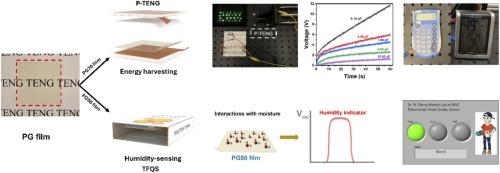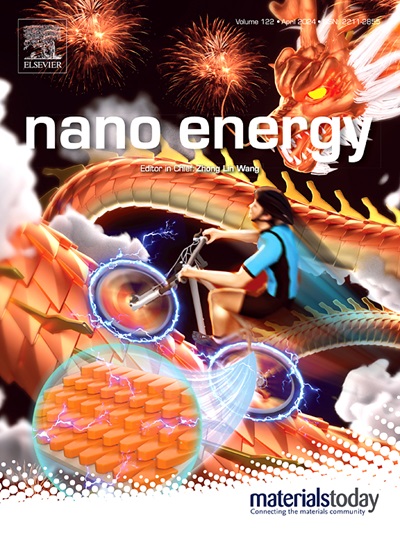Carbohydrate polymer-based triboelectric devices for energy harvesting and intelligent packaging for food-quality monitoring
IF 16.8
1区 材料科学
Q1 CHEMISTRY, PHYSICAL
引用次数: 0
Abstract
Humidity can significantly impact the quality of food. In the case of low-moisture foods – a category characterized by its low water activity – humidity can cause undesirable physical and chemical changes. In this study, we developed intelligent packaging for such foods based around versatile triboelectric nanogenerators (TENGs) that incorporated triboelectric layers fabricated from a carbohydrate polymer, pectin, and glycerol. We found that such TENGs generated their highest electrical output, making them suitable for use as energy harvesters, when the glycerol content of such a layer was 70 % of its pectin content. We further demonstrated that such energy harvesters could successfully convert mechanical energy into sufficient electricity to power small electronic devices such as a hygrometer and a calculator. However, when the pectin-containing triboelectric layer’s glycerol content was reduced to 50 % of its pectin content, the resulting TENG-based sensors exhibited distinctive behaviors during sorption and desorption processes. Those behaviors were leveraged to create a triboelectric food-quality sensor (TFQS) that we integrated into food packaging for food-quality monitoring. Testing of the TFQS indicated that it could effectively measure a key quality attribute, hardness, of our target low-moisture food, crackers. These findings illustrated not only how altering their compositions can endow triboelectric devices with multifunctionality, but also such devices’ potential to help reduce food waste by providing consumers with accurate, dynamic quality information. As such, they could address a core limitation of the current pre-printed food-date label system, which does not account for storage conditions.

基于碳水化合物聚合物的三电装置,用于能量收集和食品质量监测的智能包装
湿度会显著影响食品的质量。在低水分食品的情况下-一类以其低水分活性为特征的食品-湿度会引起不希望的物理和化学变化。在这项研究中,我们基于多功能摩擦电纳米发电机(TENGs)为这类食品开发了智能包装,该发电机结合了由碳水化合物聚合物、果胶和甘油制成的摩擦电层。我们发现,当这种层的甘油含量为其果胶含量的70%时,这种teng产生了最高的电输出,使其适合用作能量收集器。我们进一步证明,这种能量收集器可以成功地将机械能转化为足够的电能,为小型电子设备供电,如湿度计和计算器。然而,当含有果胶的摩擦电层的甘油含量降低到其果胶含量的50%时,所得的基于teng的传感器在吸附和解吸过程中表现出不同的行为。这些行为被用来创造一种摩擦电食品质量传感器(TFQS),我们将其集成到食品包装中,用于食品质量监测。测试结果表明,该方法能够有效地测量低水分食品饼干的硬度这一关键质量属性。这些发现不仅说明了改变它们的成分如何赋予摩擦电装置多功能,而且还说明了这种装置通过向消费者提供准确、动态的质量信息来帮助减少食物浪费的潜力。因此,它们可以解决当前预印食品日期标签系统的一个核心限制,即不考虑储存条件。
本文章由计算机程序翻译,如有差异,请以英文原文为准。
求助全文
约1分钟内获得全文
求助全文
来源期刊

Nano Energy
CHEMISTRY, PHYSICAL-NANOSCIENCE & NANOTECHNOLOGY
CiteScore
30.30
自引率
7.40%
发文量
1207
审稿时长
23 days
期刊介绍:
Nano Energy is a multidisciplinary, rapid-publication forum of original peer-reviewed contributions on the science and engineering of nanomaterials and nanodevices used in all forms of energy harvesting, conversion, storage, utilization and policy. Through its mixture of articles, reviews, communications, research news, and information on key developments, Nano Energy provides a comprehensive coverage of this exciting and dynamic field which joins nanoscience and nanotechnology with energy science. The journal is relevant to all those who are interested in nanomaterials solutions to the energy problem.
Nano Energy publishes original experimental and theoretical research on all aspects of energy-related research which utilizes nanomaterials and nanotechnology. Manuscripts of four types are considered: review articles which inform readers of the latest research and advances in energy science; rapid communications which feature exciting research breakthroughs in the field; full-length articles which report comprehensive research developments; and news and opinions which comment on topical issues or express views on the developments in related fields.
 求助内容:
求助内容: 应助结果提醒方式:
应助结果提醒方式:


